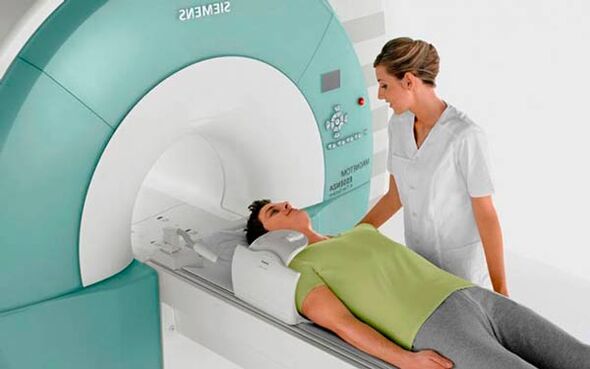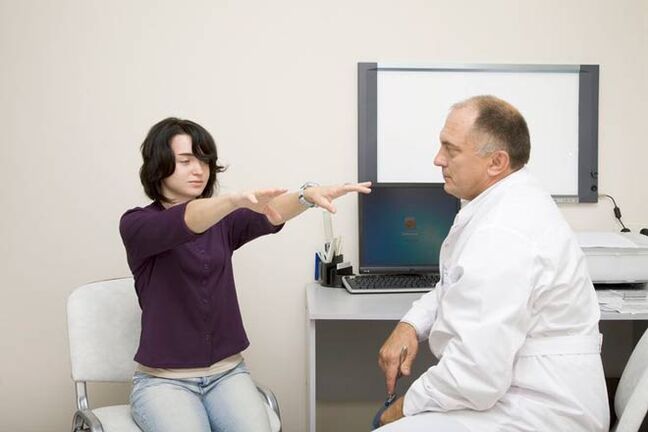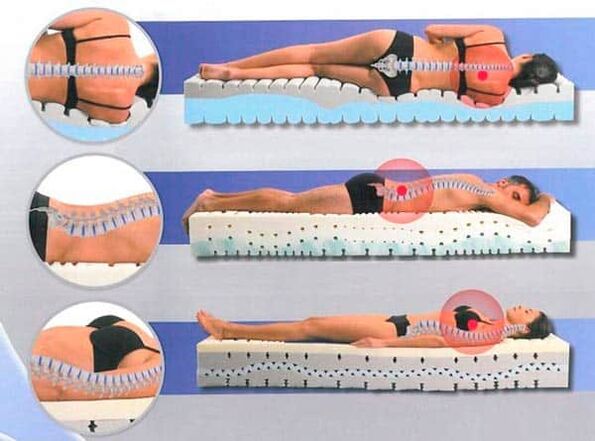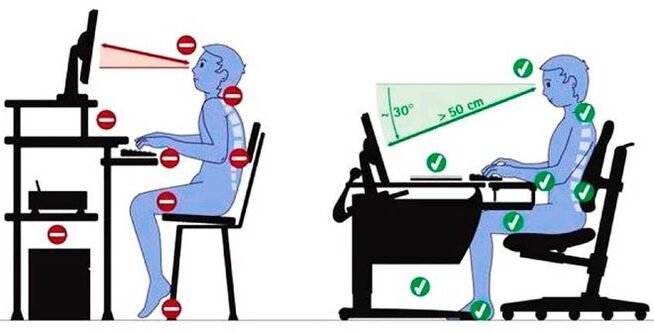Due to relative inactivity and anatomical features, osteochondrosis rarely affects the thoracic region, but this disease cannot be called rare. Therefore, if you feel stiffness and pain in the shoulder blade area, it is worth finding out what is thoracic spine osteochondrosis, what are its symptoms and methods of treatment.
In fact, the disease is rarely localized in this part of the spine, but it brings unpleasant consequences and feelings no less and no more than damage to the neck and lower back. Its peculiarity can be called with certainty the "fog" of symptoms, in which even an experienced doctor can be confused at the beginning of the disease.
What is thoracic osteochondrosis?
Osteochondrosis - degenerative-dystrophic lesions of the discs between the vertebrae and the vertebrae themselves.
As already mentioned, the disease manifests itself in the thoracic region much less frequently than in the lumbar or cervical region due to such characteristics:
- the thoracic region is inactive;
- it is well fixed by the ribs and the whole chest;
- due to kyphosis (i. e. the physiological bending of the spine back) in the thoracic region, the vertebrae experience maximum stress in the anterior, more permanent part.
But, unfortunately, anyone can develop the disease, especially if there are prerequisites for it.
What does an MRI of the thoracic spine show?
The diagnosis of a disease created in the thoracic region must be made in a comprehensive manner, and MRI shows the true picture better than most studies.
How is magnetic resonance imaging done?
Everything is simple and painless - you need to lie on a bench that enters a special spherical chamber and wait a certain time until the equipment "enlightens" the body. It is worth removing all metal objects in advance and warning the staff in case of the presence of pacemakers, prostheses and other foreign things in the body.
In general, osteochondrosis was previously diagnosed exclusively by palpation - they probed the vertebrae, there is pain, which means that osteochondrosis is present. Now doctors are supplementing their knowledge with special studies, among which the most informative is MRI, which enables the determination of degenerative phenomena in cartilage and vertebrae, the determination of the presence of hernias, and the specifics of their development.
If you are not afraid of cramped spaces, you can even take a nap.

Symptoms of osteochondrosis of the thoracic spine
The symptoms of insidious osteochondrosis in the thoracic region can be successfully hidden for a long time without manifesting and causing pain or even discomfort. And later, when the damage already causes obvious manifestations, it is sometimes difficult to determine the source of painful sensations - they can give the heart, internal organs, legs. It is therefore necessary to analyze this issue in detail.
So, doctors distinguish several types of symptoms.
Reflexes are directly related to the negative effects of the disease on various receptors.
As a result, the patient feels:
- pain in the area of the shoulder blades or just below them, often surrounding and squeezing "like a hoop";
- the focus of pain can be localized in different parts of the body - in the sternum, simulating a heart attack, on the right side, masking in the liver, and even in the lower back, such as renal colic, so when diagnosing it is often necessary to undergo a comprehensive examination of internal organsto conclude that there is a problem in the back.
Symptoms of compression occur due to tightening or stretching of the nerve roots,
As a result, there may be:
- weakness in the legs, seem to refuse;
- loss of sensitivity in the limbs;
- numbness in the area of contraction, feeling of "goose bumps";
- feeling of coma in the chest;
- tension of the surrounding muscles, which can be found during massage;
- deterioration of organ function, fortunately, such neglected cases are rare.
Given the characteristics of women's physiology, sometimes the symptoms of osteochondrosis in the thoracic region are confused with other diseases.
Often the pain radiates to the mammary glands, which automatically makes a woman think about breast problems.
Drawing, regular pain is reminiscent of fibrosis, tumors and other gland problems, which is why you run to a mammologist for a consultation. And if the doctor, after examinations, examinations and mammograms, does not find any abnormalities in the structure and functioning of the mammary glands, the presence of osteochondrosis can be safely assumed.
Causes of osteochondrosis of the thoracic region
The causes of osteochondrosis for the thoracic and other regions are the same, but in order to localize the problem right here, clear preconditions are needed:
- curvature of the spine, especially the thoracic region;
- the presence of bad habits;
- wearing high-heeled shoes;
- long to be in an unnatural position, for example, behind a computer, a sewing machine, a weed garden;
- tremendous physical activity;
- hereditary predisposition to back disease;
- pregnancy that causes a shift in center of gravity;
- flat feet and refusal to wear special orthopedic insoles;
- spinal cord injury.

Signs of osteochondrosis of the thoracic region
Signs of osteochondrosis in the thoracic region are pain, stiffness, muscle tension in this area. As we have already established, reflex and compression syndromes are different, and they should be discussed in more detail.
Dorsago and dorsalgia
The most obvious reflex syndromes of the disease are dorsago and dorsalgia. What is?
Dorsago - cutting, strong, sharp pains in the spine, as if someone had stabbed him in the back. Sometimes painful feelings spread to the heart or sternum.
The feelings are so "long" that the patient is afraid to make any movement and even breathe deeply. When you palpate, you may notice muscle tension near the spine. The attack most often occurs after prolonged sitting in an awkward position and sharp changes in it. Due to the intensity of the pain and its localization in the chest, the dorsago is often mistaken for a heart attack, but the removed cardiogram clarifies the picture.
Dorsalgia is a painful pain that manifests gradually, covers the thoracic back, chest, is intensified by movements, especially by bending and turning the body, even from sneezing or riding over the bump.
It is inconvenient that it is sometimes difficult to determine the most painful area - it is about superficial or deep tissues, back or chest, which makes it difficult to establish an accurate diagnosis.

What is intercostal neuralgia called?
Sometimes pain is noticed in the intercostal spaces, then the symptom is called intercostal neuralgia, this symptom is characterized by:
- severe pain, covering the intercostal space, sometimes radiating to the lower back, arm, or shoulder blade, and lasting for hours or even days;
- rib probing pain;
- redness or pallor of the skin at the site of inflammation, burning sensation or vice versa, numbness;
- inability to breathe evenly and deeply - every breath brings pain;
- some muscles in the chest or back twitch spontaneously.
How to treat intercostal neuralgia at home
Before treating intercostal neuralgia, you need to make a correct diagnosis, because its symptoms are similar to heart disease, and if you start fighting a real myocardial problem at home, you can get huge problems.
If this is not the first attack and the doctor confirms the diagnosis, you can resort to home methods of treatment, among which the most important are:
- bed 2-3 days;
- taking sedatives to relieve pain and relieve spasms;
- use of local analgesics in gels and ointments;
- use of heating agents - plasters with mustard and peppers;
- nerve tissue regeneration by taking vitamin B;
- fixation of the spine, for this purpose a corset is used which keeps the body in the correct position and reduces the compression of the spine.
Back pain can really go away in a few days, but to avoid relapse, you will have to fight the cause itself for a few months.
Atypical signs of osteochondrosis of the breast
In addition to clinical manifestations, thoracic osteochondrosis can also have completely atypical signs, which are so easy to confuse with other ailments. Among them:
- imitation of pain in the heart or chest in women, discomfort can torment for weeks, but additional examinations do not reveal problems with the heart and chest;
- localization of pain in the iliac region, as in gastritis or colitis, or on the right side, as in the case of liver dysfunction, the diagnosis is complicated by deterioration of digestion due to failure to conduct impulses along the nerves, and here it is difficult to determine primacy;
- disorders in urination and erectile function, which also occur due to failure to conduct nerve endings.
But there is a small trace - the deterioration manifests itself closer to night, grows every hour after waking up due to constriction of nerves in the back, and after rest passes, while disorders of the heart or other internal organs are noticeable 24 hours.
How to treat osteochondrosis of the thoracic spine?
Treatment of osteochondrosis in the thoracic spine is a long thing, moreover, it is impossible to regenerate tissues, it will only be possible to slow down the process and prevent its deterioration. But that doesn’t mean you can calm down, reconcile, and do nothing, realizing the futility of the effort, because treatment will give you a chance to live and work fully, and while neglected forms won’t end fatally, it will significantly ruin your life.
Drug treatment
At the first symptoms of osteochondrosis, drug treatment involves the use of pain relievers, for which purpose it is best to take nonsteroidal anti-inflammatory drugs.
They are prescribed for 1-2 weeks, during which time the pain usually passes.
Taking tablets, capsules or suppositories can be combined with local analgesics or compresses (although they can cause allergies, so you need to drip on a small area of skin and wait half an hour before use), similar ointments are also suitable.
Sometimes with pains of special strength, anti-inflammatory drugs are powerless and then analgesics in the form of drops are saved.
In some cases, you have to inject painkillers right next to the spine, a procedure called paravertebral blockade, performed by a doctor at the hospital.
Later, muscle relaxants are used to relax muscles, diuretics are prescribed against edema around nerve endings, and blood circulation and tissue regeneration restore trophies. In the future, to prevent relapses, you will need to drink chondroprotectors for several months.

Home treatment
At home, you can resort to many non-drug methods of treating osteochondrosis, such as:
- massage;
- Exercise therapy;
- stretching exercises;
- compresses and infusions to normalize metabolism in the vertebrae.
As for the last point, here you can advise such folk remedies:
- rub tincture of calendula, for this take 200 grams of vodka, triple alcohol and camphor alcohol per 100 grams of flowers, insist 14 days and rub into the affected area before bedtime, wrapping it in a warm scarf;
- mix the same amount of orange peel and lemon balm and pour a glass of boiling water, leave for an hour, strain, add 1 tsp. tincture of valerian and honey, drink ½ glasses twice a day for a month.
Exercises for the thoracic region
Exercises for osteochondrosis in the thoracic region may be the most effective in preventing later complications.
Gymnastics relieves stiffness, relaxes muscles, strengthens them and increases a person's physical activity. Constant and regular training speeds up blood circulation, removes inflammation of the nerve roots, reduces stress on the spine, and this exercise therapy is suitable not only for damage in the thoracic region, but also for any part of the spine.
But doctors do not recommend the use of such a series of exercises in periods of serious deterioration, general ill health, coordination problems, high blood pressure and arrhythmias.
Before training, it is better to take a shower, stretch the muscles by massaging and warming up.
So, the best exercises:
- raise your shoulders in turn 10 times;
- turn your head to the sides, freezing in extreme places for a few seconds;
- put your hands on your back under your shoulder blades, bend over and freeze for 10 seconds;
- in a standing position bend to the side, touching the knee with the shoulder, repeat in the other direction;
- lying on the floor, we place the roller under the thoracic region, place the hands behind the head and raise the shoulders, and then move the roller a little more, this movement is intended to stretch this part of the spine;
- lying on our stomachs, we raise our chests above the floor, first arms outstretched forward, then with arms outstretched to the side, and finally those joined at the back in a lock.
Such a filling helps to forget about back problems for many months.
Massage
Massage in the case of osteochondrosis of the thoracic region helps relieve pain, improve blood circulation and lymph outflow, relieve muscle cramps, improve their tone and strengthen trophism in the intervertebral cartilage.
As a rule, the course does not start immediately on the first day, but after 3-4 days, when the main unpleasant sensations have already disappeared, in rare cases the masseur can help during the period of deterioration.
The first sessions must be gentle, without excessive pressure on the tissues; skilled hands and special massage devices are also suitable as skills. It is not worth performing a massage without proper experience and education - you can only make the problem worse, so do not save on a course from a professional.
Manual therapy
At first glance, manual therapy is similar to massage - the same caressing with the hands, but in reality the chiropractor, unlike the massage therapist, does not act on the muscles and skin, but on the vertebrae themselves, which requires more strength and skill.
He uses percussion techniques, alternating tension and muscle relaxation, bending the spine to eliminate disorders in the structure of the spine and instrumental methods in the treatment of elderly patients.
A specialist in manual therapy is able to improve the tone of the back muscles, restore the mobility of the spine, correct its curvature and prolapse of the spine, and improve blood circulation.
Prevention is the best treatment
To prevent the onset of this nasty disease, you will have to make an effort, but it will pay off. Recommended:
- monitor your weight, because extra pounds are an extra burden on your spine;
- eat well and varied;
- avoid hypothermia of the spine;
- doing sports, especially when inactive work, swimming is perfect;
- take breaks and warm up at work (some exercises from the above complex will succeed);
- change poses when you are at the computer for a long time, at the table;
- avoid excessive stress on the spine.

Dietary adjustment
The condition of joints, blood vessels and bones is directly dependent on diet, and if symptoms of osteochondrosis appear, it is worth correcting them. Therefore, it is worth excluding:
- smoked meat that clogs the body;
- fried, which causes the appearance of extra pounds;
- sweet;
- soda, especially sweet.
Instead, go to:
- cooked meat and pork, chicken and rabbit stews;
- vegetables;
- cabbage;
- dairy products, especially kefir, cheese and cottage cheese;
- cooked fish at least once a week;
- fruits, apples are better.
Correct position in sleep
Osteochondrosis of the chest dictates its rules even in sleep, requiring you to choose the most correct posture. You will have to give up your favorite belly rest - in this position the head is tilted back and the blood vessels are constricted, which interferes with blood circulation in the brain.
The best poses for the disease are:
- on the side, when all the organs and limbs are at rest and not compressed;
- on the back;
- in the position of the fetus with the legs bent to the chest, the back muscles relax well in them.
I note that no less attention will have to be paid to the bed, it should be with a solid base, a hard orthopedic mattress and a small pillow on which is placed only a head without shoulders, leaning at body level. We’re going to have to say goodbye to our favorite soft mattress and huge pillow downstairs.

Sitting position
Even sitting with chronic osteochondrosis should be correct! Tips you must strictly follow:
- avoid upholstered furniture;
- choose a chair so that your legs reach the floor and the depth is 2/3 of your thighs;
- there should be plenty of space under the table when sitting, so you don’t have to bend your legs;
- with prolonged sitting every 10-15 minutes, change position, warm up, walk;
- make sure your back is lying on your back;
- do not bend forward to avoid muscle strain;
- while driving, place a roller under your lower back to preserve the physiological bend;
- even as you relax on the sofa or bed, change position every hour, relax your back muscles, and stretch.

Osteochondrosis is not fatal, but a very unpleasant disease that must be controlled from the first manifestations. Now you know what to look out for, how to recognize by multiple symptoms, what exercises to do with osteochondrosis and beat it. Dare and be healthy!



































